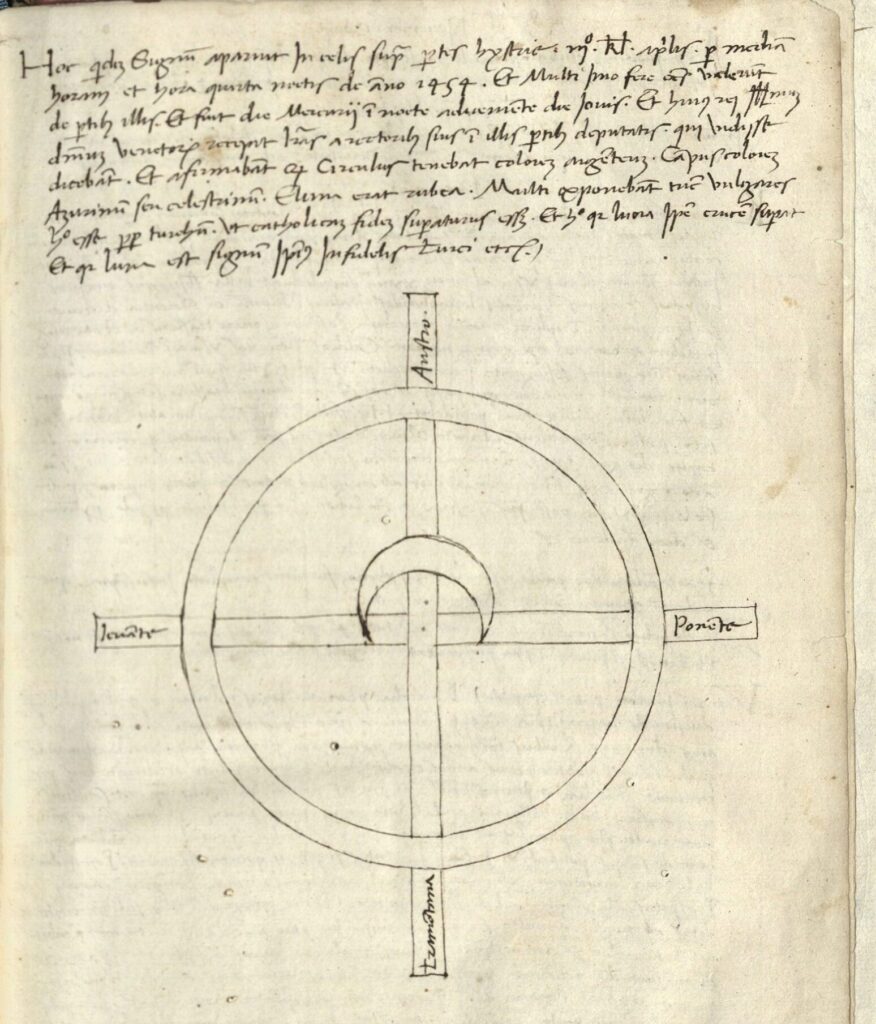Bound into the back of our 1497/98 printed edition of the works of Ovid is a four-page manuscript that offers an intriguing sidelight to our current focus on eclipses. The dense Latin script is difficult to read, so we asked our friends Daniel Williman and Karen Corsano if they could translate it for us. Their initial results—to be updated in this blog when completed—indicate that at least part of the manuscript, including a hand-drawn illustration, concerns an unusual pattern of light that was observed in the sky above Istria on the night of March 30, 1454. (Istria lies directly across the Adriatic Sea from Venice and was part of the Venetian Republic in the 15th century.)
The illustration accompanying the text on the first page of the manuscript shows a circle spanned by two bars that form a cross, with a crescent moon near the middle. At the ends of the arms of the cross are written the four cardinal directions as they were referred to when viewing the heavens, or to the directions of the wind: Austro (south), Ponente (west), Tramontana (north), and Levante (east). A great many people, “indeed almost all in those parts” according to the text, observed this circle and cross of silver against an azure sky with a red quarter-moon near its middle at about 11 p.m. that night.
 To many, the text continues, the unexplained appearance of a cross dominated by a red crescent moon was a foreboding sign of the threat posed by the Islamic empire of the Ottoman Turks, to whom the moon was an important symbol. Less than a year before, the Turks had captured Constantinople, the last vestige of the Byzantine Empire and the most significant Christian capital in the East. In fact, a week before the fall of Constantinople on May 30, 1453, a similar red crescent moon had appeared above the doomed city—the coincidental result of a partial lunar eclipse.
To many, the text continues, the unexplained appearance of a cross dominated by a red crescent moon was a foreboding sign of the threat posed by the Islamic empire of the Ottoman Turks, to whom the moon was an important symbol. Less than a year before, the Turks had captured Constantinople, the last vestige of the Byzantine Empire and the most significant Christian capital in the East. In fact, a week before the fall of Constantinople on May 30, 1453, a similar red crescent moon had appeared above the doomed city—the coincidental result of a partial lunar eclipse.
Could the celestial phenomenon observed in Istria have been a lunar eclipse? Scientists can determine with great precision when eclipses occurred in the past, and none was visible in this part of Europe on March 30, 1454. However, a lunar eclipse did occur on May 12 of that year. Perhaps the writer of the manuscript was mistaken about the date of the phenomenon.
The manuscript itself was likely written no later than the early 16th century. Whether it was originally bound with the book is unclear: its red Morocco binding was probably made in England sometime in the 18th century, so the manuscript could have been added at that time. It seems more likely, though, that the book and manuscript had been together for much longer. The only tentatively-identified owner of the Ovid prior to its appearance in England was Battista Peretti (1536?-1611), a Veronese church official, historian, and book collector.
 Please check back for updates as we learn more about this mysterious manuscript. Many thanks to Daniel Williman and Karen Corsano for their translation help!
Please check back for updates as we learn more about this mysterious manuscript. Many thanks to Daniel Williman and Karen Corsano for their translation help!
Contributed by Jeffrey Marshall, Professor Emeritus, Silver Special Collections
